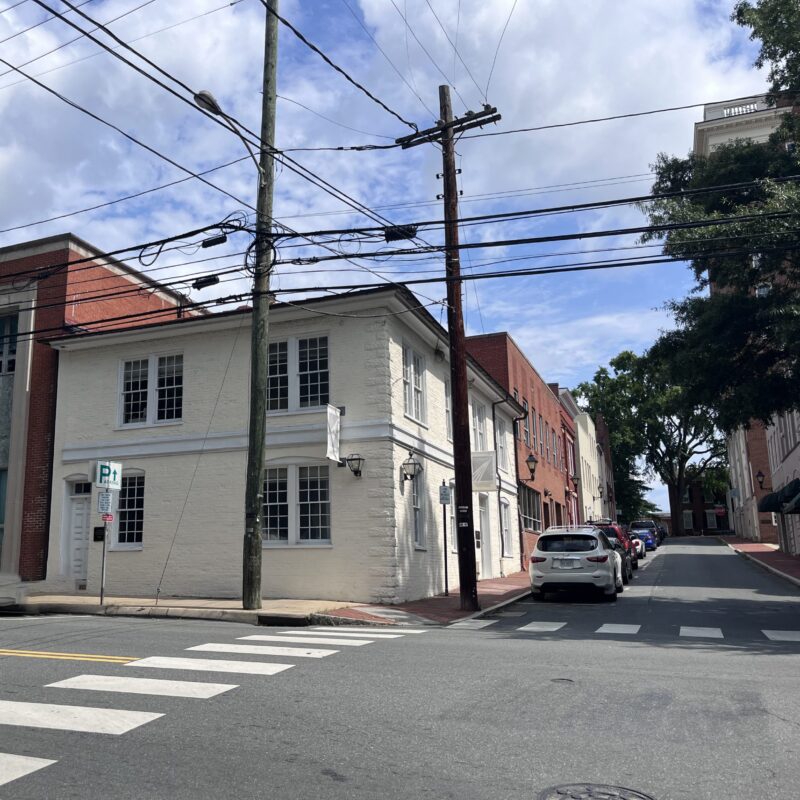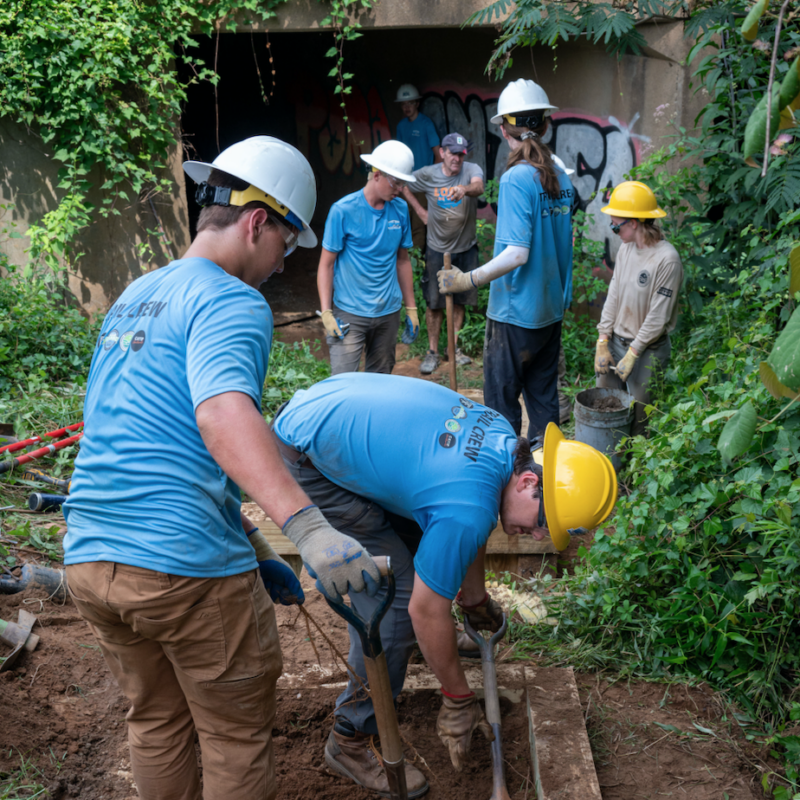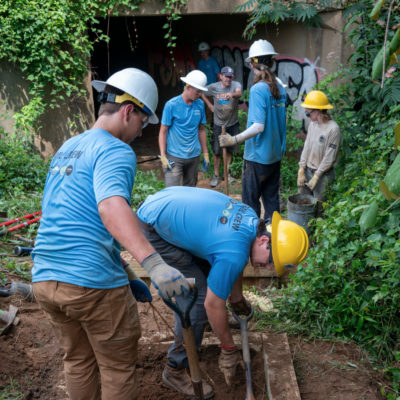Dianna Poe pulls up to the Riverside Lunch parking lot on a rainy Monday night in a white Volvo station wagon. She waves and parks. Five kids, between the ages of 10 and 17, spill out of the car and head into the burger joint on High Street. Nearly every other week, Poe takes a group of Charlottesville High School students who belong to a drop-out prevention program called WALK to Riverside. She brings her own children, too. They order with the assurance of regulars: three cheeseburgers, a veggie burger, a bacon cheeseburger, a basket of fried shrimp, drinks and three orders of French fries.
|
“We are a bit unorthodox here at WALK,” says Dianna Poe. “We’re all about relationships and kids having connections, because we really believe that you as a human being are built to connect. And if you can’t connect with someone, you won’t care about what you are doing, you won’t be successful.” |
At the table, Poe teases the girls about boyfriends and presses all the kids about how much homework they still have to do. One boy shoots her a disgruntled look, but Poe laughs. She tells him she only asks because she cares. He seems pleased. It could be one big, happy family, and in a way, it is.
Dianna Poe has gone where a lot of educators can’t or won’t go, immersing herself in her students’ sometimes difficult lives. This close connection is at the core of WALK, a two-year-old program in the Charlottesville City Schools that stands for Work Achieves Lasting Knowledge.
“We are a bit unorthodox here at WALK,” she says. “We’re all about relationships and kids having connections, because we really believe that you as a human being are built to connect. And if you can’t connect with someone, you won’t care about what you are doing, you won’t be successful.”
“We, the teachers, are in your face,” she says of the corps of four, including Poe, who manage WALK. “We hug [them], we give them our cell phone numbers, they text us at all hours, we go to dinner with them.” Just as she makes this point, her cell phone rings.
“Hello. Are you O.K.?” Satisfied with the answer, she hangs up. “It was one of my students,” Poe says. She hands me her opened flip phone. The background is a photo of Poe, sticking her tongue out. The student who just called took that picture. “I don’t know how she did it, but that’s amazing!”
Learning to WALK
WALK, which has served about 140 students annually, aims toward increasing CHS’ graduation rate, a perennial problem for the school, with a historically high dropout rate. Still, the school has made big strides toward increasing on-time graduation. According to the most recent data from the Virginia Department of Education, CHS’ 2010 dropout rate is now below the state’s, 6.8 percent compared to 8.2 percent.
Some of this is due to WALK. Using individualized technology, as well as the “in your face” human touch, Poe and her collaborators “walk” students who struggle in specific classes or subject areas through Virginia’s Standards Of Learning curriculum. There’s a lot of computer-based learning, and the ultimate goals is to “walk” across the stage at graduation.
“WALK is a small program and it has had a big impact on the students that have been in the program,” says Thomas Taylor, Charlottesville High School principal since 2008.
WALK is the brainchild of James Henderson, the city’s assistant superintendent for administration services. A 35-year veteran of public education, Henderson has also been a principal. He first met Poe in 2007.
“We had kids that were in foster care that she was assisting that were struggling in high school, failing pretty much every course they had. And we had kids that were placed in foster care who were coming from residential placements that probably did not need to be in high school,” says Henderson. “There were too many things in their lives that were hampering their success.”
Among his duties, Henderson was responsible for alternative learning. At a conference, he heard about using online learning in a typical school setting.
|
James Henderson, assistant superintendent for city schools, says that starting a program like WALK is not “rocket science,” but Dianna Poe’s perseverance and connection with the students makes all the difference. “She doesn’t give up. She wants the kids to be successful and she knows that if they don’t, their life ahead is going to be tough,” he says. |
“That kind of started the ball rolling,” says Henderson.
WALK began with a small class of about five students in the spring of 2008 as an evening program at Henry Avenue Learning Center, where students who need “intensive behavioral and academic intervention” are enrolled. Students were having some success with the nontraditional, online and computer learning program, but Henderson says administrators felt they needed more—specifically, mentors to work with them.
“There was a correlation between what we were doing and their pass rates. But at the same time, we also realized that they were asking questions and wanted things other than just getting online and learning,” says Henderson.
In the 2008-2009 year, the program at CHS graduated 43 “at risk” students. Henderson had tapped Poe to run the program, believing in her perseverance. “She doesn’t give up,” he says. “She’s got heart and she believes that these kids want to make it but they just don’t know how. She is there to kind of create that recipe for each individual kid to make it work.”
Last year, the number of graduates climbed to 56, with a total of 149 students participating.
The dropout rate at CHS has been a perennial problem, despite the fact that Charlottesville, in 2008, spent $15,143 per student (by comparison, Albemarle spent $11,713 per student). In 2007-2008, 17.8 percent of city students did not graduate, left school, or just fell through the cracks. The next year, the number declined slightly to 14.6 percent. But in 2010, the rate decreased by eight percentage points, to 6.8 percent. CHS’ on-time graduation rate for 2010 was 80.3 percent.
By comparison, in 2010, 91.6 percent of students in Albemarle County’s four high schools graduated on time, an improvement over both 2009 (89.5 percent) and 2008 (87.3 percent). The dropout rate for the 2009-2010 school year was 5.5 percent, a decrease from the previous year’s 5.7 percent. Albemarle had the 16th highest overall graduation rate among the 134 school divisions in the Commonwealth.
WALK’s annual $311,000 budget is funded by a Title I federal grant, while other grants and awards have totaled between $25,000 and $50,000 a year. Most recently, the program was awarded $30,000 by the Charlottesville Area Community Foundation’s Future Fund.
And that money goes a long way. WALK’s budget is used to pay for as many as eight of tutors, summer camp, doctor bills, food, school supplies, and even one semester at Piedmont Virginia Community College (PVCC) for a student who graduated from CHS and saw her financial aid award fall through.
A few years ago, Poe met a kid who was in a group home. “Nobody knew how old he was, and people were going to try to get him to school and…he had no clothes,” she says. “It’s amazing kids don’t have clothes. Gotta have clothes to go to school!” Unfazed, Poe took the kid, and her teenage daughter, on a shopping trip to Old Navy.
|
BY THE NUMBERS Walk the WALKWhat: WALK is a dropout prevention program for students at Charlottesville High School When: In 2008, WALK began its first full year at CHS Students enrolled since its inception: 342 Students successfully graduated in that time: 105 Credits earned through WALK: 301 Source: Thomas Taylor and Dianna Poe |
That’s typical of Poe’s dedication to get to every student who enters WALK.
“She is a mom and she has a high energy,” says Leah Puryear, chair of the Charlottesville School Board. “She really wants to see all the students succeed. She does not have any preconceived notions about anybody…There are students of all races and ethnicities, there are students in the WALK program from all socioeconomic backgrounds, but her position is, ‘You know what? All these kids could be mine, so what would I do if they were my children?’”
Kathleen Galvin, a fellow School Board member, agrees. “Dianna Poe is a phenomenal human being. She is very dedicated. You would never know how WALK would be without that personality involved.”
Up from the Lone Star state
Dianna Poe was born in Temple, Texas, 46 years ago and has lived in Virginia since 1987 and in Charlottesville since 1993. Before landing a job on Capitol Hill for an Oklahoma Congressman and meeting her husband, Chris, who is from Virginia, Poe earned her Bachelor’s degree in Political Science from Oklahoma State University. “I really thought I’d be out of here in about four years … so, there you go,” she says with a hearty laugh. Ah, love.
Poe’s big personality matches her Texan roots. The day we met she led me to her small office in the administration wing of CHS. Along the way, she stopped, greeted every single person who walked by, like a Duracell bunny charged and recharged by her contact with the world. Once in the office, she sat and relaxed. Not once, even when recounting the tragedies she has witnessed, did she frown. What motivates her, I wanted to know. “It’s just what you do. Does that sound silly?” she asks. “It’s a passion.”
“I grew up without a father, which could be a reason I do this, too,” she adds.
Even someone with a positive personality like Poe’s can struggle to cope with the trauma facing her students. Sometimes she breaks down after a full day of listening to stories of the physical abuse her students are subjected to, so severe at times that she has been driven to call social services. She confesses her stress to her husband when they’re alone on the porch. Or, she exercises.
“I run a lot. I’ll run back here on these trails,” she says pointing towards the green, open spaces south of CHS. “That’s good for me. I can’t sit here and tell you ‘I do A, B and C and it’s really nice.’ I’d be lying, but it’s an honor, too. It is really an honor to be with these kids, it’s an honor to know them.”
The trauma, “whether it be family abuse or they have been in jail or they have been in foster care, or they had a substance abuse problem and missed a semester of classes,” courses through everything the students do.
While in her office, Poe shows me a hand-written letter addressed to one of her WALK co-workers. It is from a former student, currently in jail, thanking the instructor for keeping him in her thoughts. “He is a kid, not a thug,” says Poe.
Getting the kids to succeed at their online coursework is huge, of course, but relating to students on a human level is vital, she says. “They want to know you are flawed. They really want to know that you are flawed. And I am very flawed,” she says. “They don’t want you to have it all together and be perfect. They want to see you frustrated; they want to see you have a bad day.”
I ask her whether she has ever felt uncomfortable being viewed as a mother figure. For about a minute, Poe remains in deep thought. I ask her whether it even matters. “I don’t care,” she replies. “I mean, I do have boundaries, but I love [the students].”
Poe says she’s only felt her well-being threatened once and that student is now in jail on an unrelated matter. “Most of these kids—there’s nothing to be scared about. They are kids looking for someone to love them.”
She had a big ah-ha moment this summer. While hosting a fried chicken dinner for students who graduated late and did not get to walk across the stage, Poe saw how nonetheless proud the students and their families were. They could do it! “It’s those moments that I go ‘Oh, this is why I do this.’ They were so proud, as if they were graduating from Harvard, and that was priceless.”
Poe is quick to acknowledge that WALK works because of a combination of factors. “I don’t think the simple act of handing a kid a computer magically transforms them and makes them better students,” says Taylor, the CHS principal. “But I think it helps and I think our kids, no matter what their economic background or social background, are easily engaged by technology … They want to be able to communicate in a fast paced 21st-century global tomorrow.” Add one-on-one attention and flexibility and there seems to be a good recipe at work. For Puryear, who manages Upward Bound, a college preparatory program at UVA, WALK’s appeal is in its flexible scheduling. “When you are in an academic environment that allows flexibility for that, then you stand a chance of doing well,” she says.
And students react in unexpected ways to the learning, says Galvin. “The kids also feel the freedom to become more academically oriented—when you see what they have read, from Jane Austen and Shakespeare—and they may not have thought that was stuff that they could or should be interested in. They find out what great literature is all about,” she says.
But, says Galvin, the one-on-one attention makes all the difference with WALK. “I think back to our Founding Fathers—Jefferson, Adams, George Washington. What was their mode of education when they were children? Tutoring. They were tutored one-on-one and they didn’t go into a classroom until it was the public school, which was college,” she says.
There are concerns, however. Henderson says that though WALK has done a great job reaching those kids who need help, “we need to continue to counsel students that high school is not the end of the road. We need to look at the next steps: community colleges, apprenticeships and even four-year college.”
The School Board is looking at facilities to house an expanded version of the program, which has already branched out to Buford Middle School.
According to the U.S. Department of Education, a college degree improves a graduate’s chances of getting a job by 50 percent. Also, college graduates can get jobs with better benefits than those with only a high school diploma.
That’s precisely how 19-year-old Airea Garland sees it, too. Garland graduated from CHS in 2009 through WALK. “I got into it because I actually got kicked out of school in my 10th grade year for cutting,” she says. “I am now a student at PVCC and plan on transferring to Hampton University in the spring.”
|
Charlottesville High School Principal Thomas Taylor greets students as they walk between classes. Since 2007, CHS’ dropout rate has decreased by eight percentage points and WALK has taken some of the credit. “The WALK classroom is a very different classroom environment. It’s looking at meeting some of the other needs that the kids have,” he says. “They provide school supplies to kids who need them, and food, snacks. A banana at the right time of day, that’s great. It’s really smart thinking.” |
An upbeat young woman, Garland wants to work with autistic kids. Her relationship with Poe has changed her life. “She is actually my mentor and I look up to her dramatically,” says Garland.
But, initially, the two did not see eye to eye. “At the beginning of our relationship and in meeting with her, I didn’t like her at all and it wasn’t even for the fact of who she was, I was just really upset about being kicked out of school for reasons that I felt I didn’t have any control over,” she says.
Things changed when Poe reached out. “Miss Poe pulled me to the side, which made me respect her more, she pulled me to the side and asked me personally why I was there and how that made me feel” says Garland.
And that relationship thrives. Garland still checks in with Poe and other members of WALK.
“I still go there and I see students who are not embracing the experience,” she says. “I would encourage them and I have encouraged them that it’s a learning experience and that WALK can help you in so many ways … and to have people working with you like Miss Poe, I feel like it’s a really good advantage to have.”
Many costs, no single solution
Nationally, the dropout rate remains a problem. According to the U.S. Department of Education, excluding South Carolina, the average freshman graduation rate (an estimate of the percentage of high school students who graduate on time) was 75 percent in 2007-2008.
According to “The Consequences of Dropping Out of High School,” a report from the Center for Labor Market Studies at Northeastern University, low-income high school dropouts were the least likely to be employed in 2008. Additionally, “young female dropouts were six times as likely to have given birth as their peers who were college students of four-year college graduates.” Incarceration rates are also correlated to dropout rates. According to the study, male high school dropouts were 47 times more likely to be incarcerated than four-year college graduates.
Lifetime earnings are an issue for dropouts, too. In a lifetime, a high school dropout earns $260,000 less than a high school graduate and more than $1 million less than college graduates.
In addition to making less in their lifetime, in 2007, high school dropouts cost taxpayers more than $292,000 per capita in lower tax revenues and incarceration costs, compared to a high school graduate.
WALK is but one tool among many. “It’s not a silver bullet,” says Taylor. “One program is not going to solve everything. But WALK does a really good job of meeting the niche of a handful of kids.”
In the end, dropouts are a community issue, not just a school issue, says Poe.
“I would tell you that in our world-class city, when you sit down on the Downtown Mall, I think it’s so wonderful and everybody’s having a good time and just a block away … even in Albemarle County, there are children who do not have food, who do not have a bed to sleep in. When you are not getting your basic needs met, how do you go to school and learn?” asks Poe.
Galvin agrees. “The City of Charlottesville has a dynamic that’s plagued the city for generations now, that we have a divide in our schools between kids who do exceptionally well—knock the socks off anybody in the state in terms of SAT scores, AP scores—and then we’ve got 55 percent of our student population in the Free and Reduced Lunch Program. That is an indicator of concern,” she says. “We have a greater need for intervention, a greater need for alternative education and also we, as a city, have been investing in 3- or 4-year olds, pre-school programs for disadvantage kids. It’s because we have regionally the highest number of kids who are in poverty.” Poe proposes a solution: a halfway house for kids who need a safe environment. “We wait until kids are so far gone that they are in the system, they are in group homes or they are in foster care,” she says with disappointment. “But there are kids who are right here on that edge of making it or not.”
A family affair
While Poe’s extended family dwells in the WALK classroom at CHS, her three children live in that classroom too, by extension, living with a mom who definitely brings her work home. And they love it. Her daughter, a senior in high school, has been tutoring kids in WALK and seems passionate about it. Makes you think of the old saying about the apple and the tree.
“My daughter is writing her college application essay on how WALK affected her life. She said it has definitely changed her, for the better,” says Poe, getting emotional. “That was probably one of the best things this year.”
But to outsiders, maybe Poe’s intense involvement seems detrimental to the family dynamic. Poe recalls an instance when someone said her daughter could be emotionally scarred from the experience.
“I am so proud that she has, as a 17-year-old girl, so much empathy for someone else. To me, that’s what life is about, not about just being Lindsay Lohan. I am so proud of her. I think it’s a good hardship to have.”








